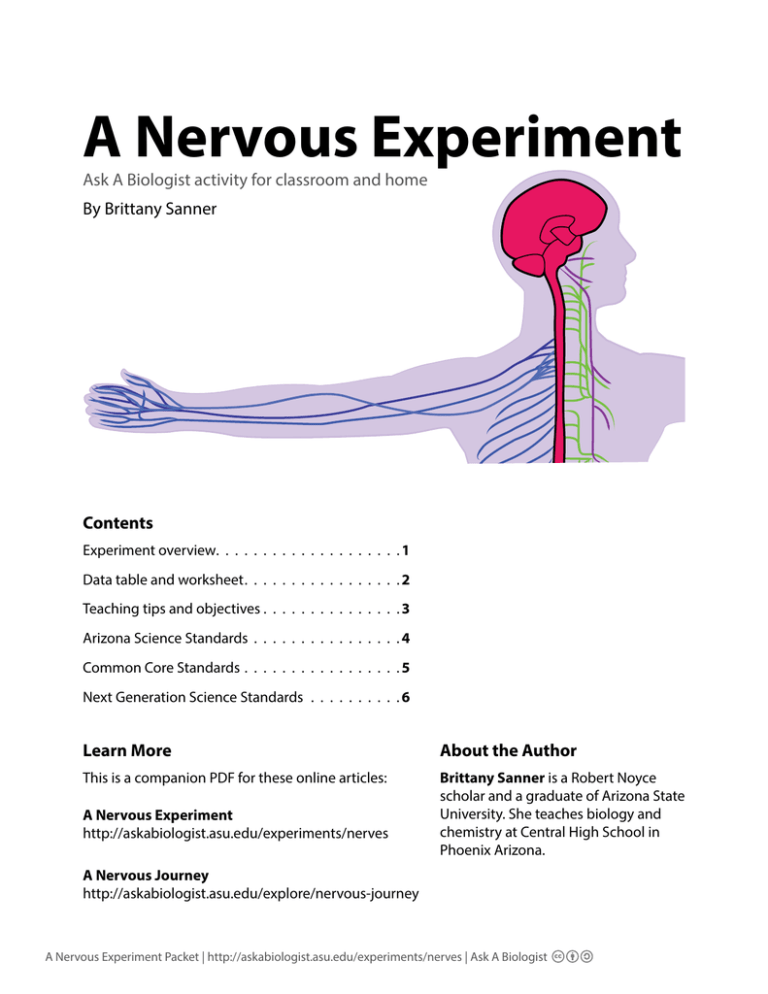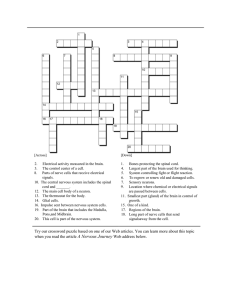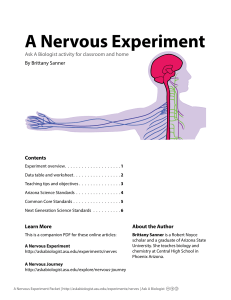Nerve Experiment - Ask A Biologist
advertisement

A Nervous Experiment Ask A Biologist activity for classroom and home By Brittany Sanner Contents Experiment overview. . . . . . . . . . . . . . . . . . . . 1 Data table and worksheet. . . . . . . . . . . . . . . . . 2 Teaching tips and objectives. . . . . . . . . . . . . . . 3 Arizona Science Standards . . . . . . . . . . . . . . . . 4 Common Core Standards. . . . . . . . . . . . . . . . . 5 Next Generation Science Standards. . . . . . . . . . 6 Learn More About the Author This is a companion PDF for these online articles: Brittany Sanner is a Robert Noyce scholar and a graduate of Arizona State University. She teaches biology and chemistry at Central High School in Phoenix Arizona. A Nervous Experiment http://askabiologist.asu.edu/experiments/nerves A Nervous Journey http://askabiologist.asu.edu/explore/nervous-journey A Nervous Experiment Packet | http://askabiologist.asu.edu/experiments/nerves | Ask A Biologist Experiment Overview How do you know when your hand touches something? How do you know if something brushes against your shoulder? As you learned in A Nervous Journey, neurons of the nervous system sense things in the environment and send those signals to the brain for analysis. Each neuron can only send one signal at a time. If two points touch the same neuron, it can still only send one signal to the brain. This means, your brain would only sense one thing touching you, even when there are two. Knowing this, do you think you need the same number of nerves in every part of your body? Think about your fingertip, arm and back. In which of these places might your nerves be closer together? Make your predictions and see for yourself in the experiment below! Hypothesis Explain which part of your body (fingertip, arm or shoulder) will be most sensitive and explain why: If________________________________________________________________________________________ then______________________________________________________________________________________ because___________________________________________________________________________________ Materials • 1 ruler with centimeters • 1 Paperclip • Paper and a pencil Procedures Step 1: Open your paper clip. Spread the ends and use the ruler to measure the distance between them. Adjust them until they are exactly 4cm apart. Step 2: Touch both ends of the paper clip to your finger tip. A gentle touch is all that is required. If you feel both ends, write a “2” in the first square in the chart as shown in the example above. If you only feel one paper clip end, that means both ends of the paper clip are touching the same neuron. If this happens, write a “1” in the appropriate square in your table. Step 3: Repeat this on your upper arm and back, and record your results in your table. (Hint: If you have a hard time reaching your back, ask a partner for help.) Step 4: Using your ruler, push the paper clip ends 1/2 centimeter closer together. Repeat steps 2 and 3, bringing the paper clip ends closer each time until they are touching. A Nervous Experiment Packet | http://askabiologist.asu.edu/experiments/nerves | Ask A Biologist 2 Experiment Overview Use the table below to record your results. Distance between paperclip ends Fingertip Upper arm Back 4 cm 3.5 cm 3 cm 2.5 cm 2 cm 1.5cm 1 cm .5 cm ends touching Analysis and Conclusions: 1. What was the independent variable in this experiment? How do you know? _____________________________________________________________________________________ _____________________________________________________________________________________ 2. What was the dependent variable in this experiment? How do you know? _____________________________________________________________________________________ _____________________________________________________________________________________ 3. What patterns did you see in your data? _____________________________________________________________________________________ _____________________________________________________________________________________ 4. Which part of the body was least sensitive? _____________________________________________________________________________________ _____________________________________________________________________________________ 5. Which part of the body is most sensitive? Why do you think that is? _____________________________________________________________________________________ _____________________________________________________________________________________ 6. Was your hypothesis supported? Why or why not? Use your data to explain your answer. _____________________________________________________________________________________ _____________________________________________________________________________________ 7. What further questions does this experiment raise, and what could you do to investigate the answers to those questions? _____________________________________________________________________________________ _____________________________________________________________________________________ A Nervous Experiment Packet | http://askabiologist.asu.edu/experiments/nerves | Ask A Biologist 3 Teaching Tips It is often a challenge to add a human anatomy and physiology activity to the classroom that is easy to implement and inexpensive. I have used this experiment with students to test the sensitivity of nerves located in different parts of the body. Tips for Classroom Implementation Time required: As little as 20 minutes if the concept has already been introduced and the data table is supplied. Classroom set up: Supply one paper clip per student and at least one ruler per table. (Students can share rulers.) Students should record their own data. Tips • This is an easy experiment for students to perform individually, but most students prefer help from a partner. If done in partners, warn students to poke gently. The first time I did this experiment, one of my students ended up with a bloody nose from an ill placed paperclip poke (and I teach high school students). Ever since then, I have warned students. They scoff and roll their eyes, but there haven’t been any more injuries. • Certain students may insist they feel two points even when only one point is used. For these students, working with a partner may work best so they can concentrate on what they feel rather than what they are doing. Sharing data as a class will also help these students relate what they feel to what everyone else experienced. Extensions • More advanced students should be able to produce the data table on their own without the pdf printout or instructions. • Have students write a formal hypothesis explaining their reasoning and conclusion explaining their data and why it either supported or did not support their initial hypothesis. • This experiment could lead to follow up questions or experiments giving the students the opportunity to design and implement their own experiment. Examples include testing which finger is most sensitive, comparisons to other parts of the body including feet or toes, or reactions to hot and cold. Objectives 1. Students will investigate the action of their nervous system. 2. Students will collect and compare data from three different parts of the body. 3. Students will interpret data and form conclusions. A Nervous Experiment Packet | http://askabiologist.asu.edu/experiments/nerves | Ask A Biologist 4 Arizona Science Standards Strand 1: Inquiry Process Concept 1: K-4 Observations, Questions, and Hypotheses Observe, ask questions, and make predictions. 5-8 Observations, Questions, and Hypotheses Formulate predictions, questions, or hypotheses based on observations. Locate appropriate resources. HS Observations, Questions, and Hypotheses Formulate predictions, questions, or hypotheses based on observations. Evaluate appropriate resources. Concept 2: K-4 Scientific Testing (Investigating and Modeling) Participate in planning and conducting investigations, and recording data. 5-8 Scientific Testing (Investigating and Modeling) Design and conduct controlled investigations. HS Scientific Testing (Investigating and Modeling) Design and conduct controlled investigations. Concept 3: K-4 Analysis and Conclusions Organize and analyze data; compare to predictions. 5-8 Analysis and Conclusions Analyze and interpret data to explain correlations and results; formulate new questions. HS Analysis, Conclusions, and Refinements Evaluate experimental design, analyze data to explain results and to propose further investigations. Design models. Strand 4: Life Science Concept 1: K-4 Characteristics of Organisms Understand that basic structures in plants and animals serve a function. 5-8 Structure and Function in Living Systems Understand the relationships between structures and functions of organisms. Concept 5: HS Matter, Energy, and Organization in Living Systems (Including Human Systems) Understand the organization of living systems, and the role of energy within those systems A Nervous Experiment Packet | http://askabiologist.asu.edu/experiments/nerves | Ask A Biologist 5 Common Core Standards Common Core Reading Anchor #3 Analyze how and why individuals, events, or ideas develop and interact over the course of a text. • RST.6-8.3: “follow precisely multistep procedure when carrying out experiments, taking measurement or performing technical tasks.” Follow the procedure written in experiment and record results, repeat procedure for each body part. For advanced students, design and implement their own procedure, as well as analyze results. Common Core Writing Anchor #1 Write arguments to support claims in an analysis of substantive topics or texts using valid reasoning and relevant and sufficient evidence. • WHST.6-8.1: “…Support claim(s) with logical reasoning and relevant, accurate data and evidence that demonstrate an understanding of the topic or text, using credible sources…” Use logical reasoning and relevant evidence from Nervous Journey text and experimental results to determine if hypotheses were supported. Common Core Writing Anchor #7 Conduct short as well as more sustained research projects based on focused questions, demonstrating understanding of the subject under investigation. • • WHST.6-8.7: …answer a question (including self-generated question)…generating additional related, focused questions that allow for multiple avenues of exploration WHST.9-12.7: “…narrow or broaden inquiry when appropriate…” Follow the procedure written in experiment and record results, repeat procedure for each body part. For advanced students, design and implement their own procedure, as well as analyze results. A Nervous Experiment Packet | http://askabiologist.asu.edu/experiments/nerves | Ask A Biologist 6 Next Generation Science Standards Life Sciences Disciplinary Core Idea Standards: (www.nextgenscience.org - Appendix E) LS1.A Structure and Function: • 3-5: organisms have internal and external structures that allow for growth, survival, behavior, and reproduction • 6-8: cells work together to form tissues and organs specialized for body functions • 9-12: organisms have systems of specialized cells to perform essential functions with feedback mechanisms. LS1.D Information Processing • K-2: Animals sense and communication information and respond to inputs • 3-5: Different sense receptors are specialized for particular kinds of information • 6-8: Sense receptors transmit signals through nerve cells to the brain, which results in behaviors or memories Science and Engineering Practices: (www.nextgenscience.org - Appendix F) Asking questions and defining problems (Related to Common Core RST 7, WHST 7) • 6-8: Ask questions that arise from careful observation, determine independent and dependent variables, and empirical evidence • 9-12: Formulate, refine and evaluate empirically testable questions and design problems using models and simulations Planning and carrying out investigation (Related to Common Core RST 3) • 3-5: Conduct investigation with control variables, make predictions about changing variables, and make observations/measures to produce data to evaluate predictions • 6-8: Conduct an investigation with multiple variables, collect and evaluate data Analyzing and interpreting the data (Related to Common Core RST7, RST9) • K-2: Record and share observations • 3-5: Introduce quantitative approaches, using multiple trials, represent data in tables or graphs, compare and contrast data Constructing Explanations and Designing Solutions (Related to Common Core RST1, RST8) • K-2: Make observations to construct evidence-based accounts for natural phenomenon • 3-5: Use evidence in constructing explanations of observed relationships between specific variables A Nervous Experiment Packet | http://askabiologist.asu.edu/experiments/nerves | Ask A Biologist 7







